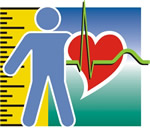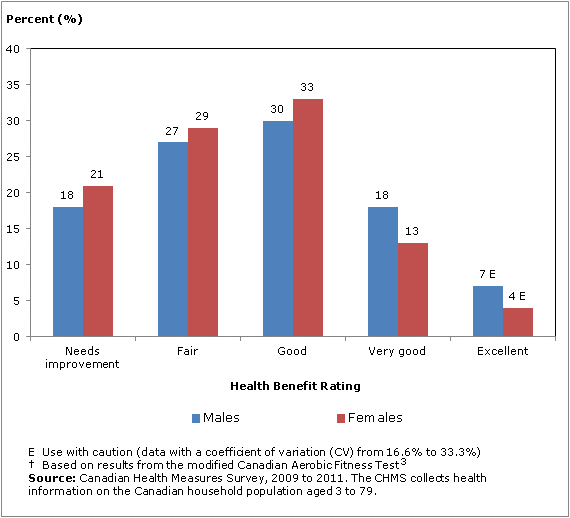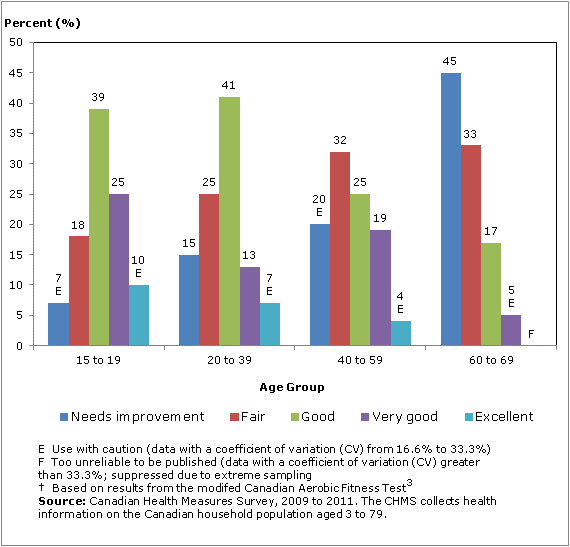Aerobic fitness of Canadians, 2009 to 2011
Archived Content
Information identified as archived is provided for reference, research or recordkeeping purposes. It is not subject to the Government of Canada Web Standards and has not been altered or updated since it was archived. Please "contact us" to request a format other than those available.

Among Canadians aged 15 to 69, 47% are categorized as having a "Fair" or "Needs improvement" health benefit rating based on their aerobic fitness, with even higher numbers for Canadians aged 40 and over.
The health benefits of physical fitness are widely acknowledged. Higher levels of aerobic fitness are associated with a reduced risk of cardiovascular disease, some types of cancer, osteoporosis, diabetes, obesity, high blood pressure, depression, stress and anxiety.Note 1, Note 2 Aerobic fitness, or cardiorespiratory fitness, refers to endurance or the ability to sustain physical activity. It includes the ability to take in oxygen during prolonged physical activity, as well as the body's ability to transport oxygen to the muscles.
The Canadian Health Measures Survey (CHMS) measured aerobic fitness using the modified Canadian Aerobic Fitness Test (mCAFT).Note 3 The results of the mCAFT are used to determine a health benefit rating, which indicates the level of health benefit or risk associated with an individual's aerobic fitness. The ratings range from "Excellent" (optimal health benefits) to "Needs improvement" (considerable health risks).
Health benefit ratings
In Canada, 45% of males and 50% of females aged 15 to 69 had either a "Needs improvement" or a "Fair" health benefit rating. Overall, only 25% of males and 17% of females were categorized as having "Very good" or "Excellent" health benefit ratings. The remainder (30% and 33%, for males and females, respectively) had a health benefit rating of "Good" (Chart 1). No significant differences between sexes were found for any of the categories.
Chart 1
Distribution of the household population aged 15 to 69, by health benefit rating† and sex, Canada, 2009 to 2011

Older adults tend to have lower health benefit ratings than younger adults, with 52% of 40 to 59 year olds and 78% of 60 to 69 year olds having a "Needs improvement" or "Fair" rating compared to 25% among 15 to 19 year olds and 40% among 20 to 39 year olds. Only 48% of 40 to 59 year olds and 22% of 60 to 69 year olds had health benefit ratings of "Good", "Very good" or "Excellent", compared with 74% of 15 to 19 year olds and 61% of 20 to 39 year olds (Chart 2). This age-related decline in aerobic fitness is a well-known phenomenon.Note 4, Note 5
Chart 2
Distribution of the household population aged 15 to 69, by health benefit rating† and age group, Canada, 2009 to 2011

About aerobic fitness
Aerobic fitness is a measure of the combined efficiency of the lungs, heart, bloodstream and exercising muscles in getting the oxygen to muscles and putting them to work. A larger aerobic capacity increases the body's efficiency to perform daily activities,Note 3 and reduces the risk of several chronic diseases.Note 2 Improvements in aerobic fitness are achieved through regular participation in moderate-to-vigorous physical activity. The CHMS measured the aerobic fitness of Canadians using the modified Canadian Aerobic Fitness Test,Note 3 which consists of one or more sessions of three minutes of stepping at predetermined speeds based on age and sex.References
- Gilmour H. Physically active Canadians. Health Reports. 2007;18(3):45-65.
- Warburton D, Charlesworth S, Ivey A, Nettlefold L, Bredin S. A systematic review of the evidence for Canada's Physical Activity Guidelines for Adults. International Journal of Behavioral Nutrition and Physical Activity. 2010;7:39.
- Canadian Society for Exercise Physiology. The Canadian Physical Activity, Fitness, and Lifestyle Approach (CPAFLA). Third ed. Ottawa, ON: Canadian Society for Exercise Physiology; 2003.
- Stephens T, Craig C, Ferris B. Adult physical fitness and hypertension in Canada: findings from the Canada Fitness Survey II. Canadian Journal of Public Health. 1986;77:291-5.
- Carnethon M, Gulati MR, Greenland P. Prevelance and cardiovascular disease correlates of low cardiorespiratory fitness in adolescents and adults. Journal of the American Medical Association. 2005;294(23):2981-8.
For more information on the Canadian Health Measures Survey, please contact Statistics Canada's National Contact Centre (toll-free 1-800-263-1136; 613-951-8116; infostats@statcan.gc.ca).
- Date modified:
